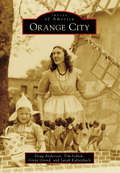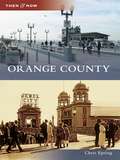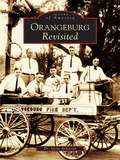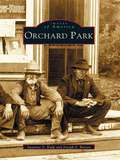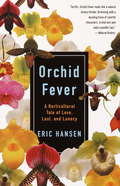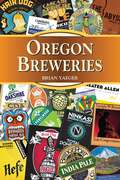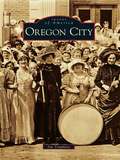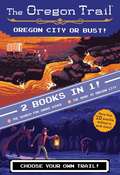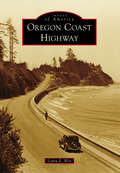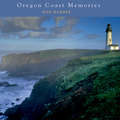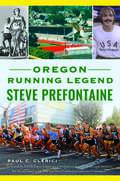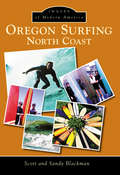- Table View
- List View
Opryland USA (Images of Modern America)
by Ty Herndon Stephen W. PhillipsBy the late 1960s, the Ryman Auditorium--the fifth home of the Grand Ole Opry--was a deteriorating firetrap in a seedy part of Nashville, yet it still attracted thousands of people each weekend to the "show that made country music famous." In an effort to develop an attraction that could sustain a larger Opry all week long, Opryland was born. Opryland USA operated from May 27, 1972, until December 31, 1997, attracting millions of visitors each year and giving many celebrities their first taste of show business. The park consisted of nine areas, dozens of rides, and Broadway-caliber shows featuring live bands and orchestras. As the "Home of American Music," Opryland USA still lives on in the hearts and minds of those who visited its wooded trails, lazy streams, exciting attractions, and toe-tapping performances.
Oracle Bones: A Journey Through Time in China
by Peter HesslerA century ago, outsiders saw China as a place where nothing ever changes. Today the country has become one of the most dynamic regions on earth. In Oracle Bones, Peter Hessler explores the human side of China's transformation, viewing modern-day China and its growing links to the Western world through the lives of a handful of ordinary people. In a narrative that gracefully moves between the ancient and the present, the East and the West, Hessler captures the soul of a country that is undergoing a momentous change before our eyes.
Orange Blossom & Honey: Magical Moroccan recipes from the souks to the Sahara
by John Gregory-SmithOrange Blossom & Honey is a culinary journey across Morocco, from the souks of Marrakesh, through the Sahara, and onto the blustery shores of the Atlantic coast. In researching this book, John travelled into the heart of the High Atlas Mountains to learn the secrets of traditional lamb barbecue, then journeyed north, through the city of Fes, where the rich dishes of the Imperial Courts are still prepared in many homes. From here he continued on to the Rif Mountains, where rustic recipes are made with the freshest seasonal produce. From Moroccan-style paella, cooked in the painted town of Chefchaouen, to stuffed Berber breads baked in the hot desert sands, John has discovered the real food of the country, learning from the locals to reveal little-known dishes, which he then gives his modern twist. The chapters include Streetfood, Salads & Vegetables, Meat & Poultry, Seafood, Tagines and Desserts, plus there is a section of spice mixes and marinades from chermoula to harissa. With mouthwatering recipes, breath-taking location photography and John's infectious enthusiasm, this is an essential addition to every cook's collection.
Orange City (Images of America)
by Doug Anderson Sarah Kaltenbach Greta Grond Tim SchlakOrange City was founded in 1869-1870 as a colony of Dutch Americans from Pella. Led by Henry Hospers, the colonists made Orange City the center of Dutch agricultural expansion in northwestern Iowa and farther west. By 1874, the town had railroad connections, was the seat of Sioux County, and had a Dutch-language weekly newspaper that was read in the Netherlands as well as around North America. Hospers, along with others, founded an academy in 1882 to train young people in the classics and the Reformed faith. By the 1930s, the academy was maturing into what is now Northwestern College. The town's populace has never been exclusively Dutch; nevertheless, the Dutch heritage of the settlement has remained central to Orange City's identity. A tulip festival held in 1936 became an annual event that continues to draw tens of thousands of visitors each May. In 1986, a Dutch-front initiative was launched that has transformed much of the town with a distinctive Dutch look.
Orange County
by Chris EptingOrange County was created in 1889. Soon, wilderness evolved into farmlands and communities supported by a year-round harvest of Valencia oranges, lemons, avocados, walnuts, and more. In the 1950s, aerospace and industry expanded here, and today the county boasts more than three million people. This collection features side-by-side historic comparisons of many local institutions, from orange groves to beaches to Disneyland. Chris Epting is the author of 17 books, including Vanishing Orange County and Huntington Beach.
Orange County Fair, The: A History of Celebration
by Chris Epting Governor Jerry BrownThe Orange County Fair is one of Southern California's most anticipated summer events. From its first year in 1890 with a few livestock exhibits and horse races, the fair evolved into what is now a month-long extravaganza of rides, games and entertainment that still celebrates the importance of local agriculture. Millions of visitors have crowded the grounds over the years to enjoy the spectacle of everything from ostrich races and demolition derbies to its unique Centennial Farm and the time-honored All-Alaskan pig race. Author Chris Epting recounts more than a century of community history and revelry at the OC Fair.
Orangeburg
by Dr Gene AtkinsonLocated along the north fork of South Carolina's Edisto River, Orangeburg enjoys an extended, rich heritage dating back to the 1730s when it was created as one of the original inland townships. The first settlers were mostly German and Swiss immigrants who found the area to be the paragon of locales, valuable in fertile soil and abundant wildlife surrounding the river. The city of today has been gently shaped by its landscape and natural life, which called people and industries to experience the benefits of such land. This volume celebrates Orangeburg's history by offering readers a rare find of more than 200 photographs from days gone by, taking them on an adventure through the town's coming of age, from the early days of photography to the 1950s. These images reveal the ways of life long past by showcasing well-known town entities such as the Courthouse Square and the Edisto Memorial Gardens, local businesses like the Orangeburg Hotel, and beloved residents, some of whom were public figures and others better remembered by their families and friends. From early-century churches to the evolution of the county fair, readers will find themselves enthralled by the history that Orangeburg possesses.
Orangeburg Revisited
by Dr Gene AtkinsonOrangeburg, South Carolina, is home to an abundant history, shown in this second volume through over 225 rare images of times gone by. The epitome of the small town, Orangeburg is where friends would gather at the famous Bluebird Theatre or the old soda fountains at a turn-of-the-century drugstore. Residents marveled when the Orangeburg Hotel was constructed in 1909; at the time it was the second tallest structure in all of South Carolina. Marchant Music Co., whose showroom is featured in this volume, recalls the days when everyone gathered around the piano in the parlor. Beauty queens from the old Fall Festival, which preceded the formation of the Orangeburg County Fair, grace the pages of this collection. Even the first motor-powered fire truck makes an appearance, as do the stalwart men who comprised the old volunteer fire departments. Also notable in this volume is the rarely mentioned George H. Cornelson, who had more impact on the city than any other person over the last 130 years.
Oranges & Peanuts for Sale
by Eliot WeinbergerPresented at the PEN World Voices Festival as a "post-national" writer, Eliot Weinberger is "a sparkling essayist" (Confrontation), and his writings "a boundary-crossing, shape-shifting cabinet of curiosities" (The Bloomsbury Review). Many of the twenty-eight essays in Oranges & Peanuts for Sale have appeared in translation in seventeen countries; some have never been published in English before. They include introductions for books of avant-garde poets; collaborations with visual artists, and articles for publications such as The New York Review of Books, The London Review of Books, and October. One section focuses on writers and literary works: strange tales from classical and modern China; the Psalms in translation: a skeptical look at E. B. White's New York. Another section is a continuation of Weinberger's celebrated political articles collected in What Happened Here: Bush Chronicles (a finalist for the National Books Critics Circle Award), including a sequel to "What I Heard About Iraq," which the Guardian called the only antiwar "classic" of the Iraq War. A new installment of his magnificent linked "serial essay," An Elemental Thing, takes us on a journey down the Yangtze River during the Sung Dynasty. The reader will also find the unlikely convergences between Samuel Beckett and Octavio Paz, photography and anthropology, and, of course, oranges and peanuts, as well as an encomium for Obama, a manifesto on translation, a brief appearance by Shiva, and reflections on the color blue, death, exoticism, Susan Sontag, and the arts and war.
Orcas Island
by Orcas Island Historical Society and MuseumOrcas Island, the largest of the 172 islands in San Juan County, lies in the Salish Sea north of Puget Sound. Known as the "Gem of the San Juans" for her shimmering emerald hills bounded by 125 miles of rocky, tree-lined shore, Orcas was home to countless generations of Native Americans before the arrival of its first white settlers, formerly Hudson's Bay men who had hunted on the island, in the late 1850s. An international boundary dispute, popularly known as the Pig War, prevented early pioneers from settling land claims until the dispute was resolved by the German kaiser in 1872. Settlement grew slowly until improved steamship routes and increased commerce brought more tourists to the island. In 1906, Robert Moran built a fabulous estate, Rosario, now a world-class resort. Thousands of visitors have been coming to Orcas Island over the years to explore her forested hills, camp in Moran State Park or stay at one of the many historic resorts, and fish in the pristine waters surrounding this island paradise.
Orchard Park
by Joseph F. Bieron Suzanne S. KulpAttracted by the fertile soil, ample forests, and abundant water, the first pioneer arrived in the Orchard Park area in 1803, making this one of the earliest settlements in western New York. Prominent among the settlers were the Quakers, who built a picturesque meetinghouse that is still in use today. Orchard Park portrays the history of the community through its citizens and their homes and businesses, many of which were at Four Corners. Plank roads and then a railroad and finally a trolley provided opportunities for the community to share in the prosperity of nearby Buffalo in the late 1800s. Old family heritage persists in the names of streets on which century-old houses still stand, connecting yesterday with today.
Orchid Fever: A Horticultural Tale of Love, Lust, and Lunacy
by Eric HansenThe acclaimed author of Motoring with Mohammed brings us a compelling adventure into the remarkable world of the orchid and the impossibly bizarre array of international characters who dedicte their lives to it.The orchid is used for everything from medicine for elephants to an aphrodisiac ice cream. A Malaysian species can grow to weigh half a ton while a South American species fires miniature pollen darts at nectar-sucking bees. But the orchid is also the center of an illicit international business: one grower in Santa Barbara tends his plants while toting an Uzi, and a former collector has been in hiding for seven years after serving a jail sentence for smuggling thirty dollars worth of orchids into Britain. Deftly written and captivatingly researched, Orchid Fever is an endlessly enchanting and entertaining tour of an exotic world."A wonderful book, I've been up all night reading it, laughing and crying out in horror and clucking at the vivid images of bureaucracy with the bit in its teeth." --Annie Proulx"An extraordinary, well-told tale of botany, obsession and plant politics. Hansen's vivid descriptions of the complex techniques some orchids use to pollinate themselves will raise your eyebrows at nature's sexual ingenuity." --USA Today
Ordeal by Hunger: The Story of the Donner Party
by George R. StewartThe tragedy of the Donner party constitutes one of the most amazing stories of the American West. In 1846 eighty-seven people -- men, women, and children -- set out for California, persuaded to attempt a new overland route. After struggling across the desert, losing many oxen, and nearly dying of thirst, they reached the very summit of the Sierras, only to be trapped by blinding snow and bitter storms. Many perished; some survived by resorting to cannibalism; all were subjected to unbearable suffering. Incorporating the diaries of the survivors and other contemporary documents, George Stewart wrote the definitive history of that ill-fated band of pioneers.
Oregon Breweries (Breweries Series)
by Brian YaegerThis comprehensive guide covers all aspects of beer and brewing in Oregon, one of the leading states in the craft brew revolution, and features 190 breweries and brewpubs.
Oregon City
by Jim TompkinsIn 1829, Dr. John McLoughlin, chief factor of the Hudson's Bay Company Columbia Department, had two small cabins constructed on an island in Willamette Falls. The Kalapuya Indians promptly burned them, but a claim had been made and the roots planted for the oldest city in the Oregon Territory. Incorporated for over 160 years as Oregon City, McLoughlin's city at Willamette Falls has served as the political capital of an independent Oregon Country and the first capital of the Oregon Territory. Considered the oldest industrial site in the West, with saw, flour, paper, and woolen mills, Oregon City was also a transportation center for covered wagons, steamboats, and railroads. As a regional entertainment hub over the years, the community has provided both residents and visitors with such pleasures as Chautauquas, Oregon's first sporting events, the first state fair, a variety of annual festivals, and an array of opera, vaudeville, and movie houses.
Oregon City or Bust!: The Search for Snake River and The Road to Oregon City (The Oregon Trail)
by Jesse WileyExplore the frontier, young pioneer! Inside, find two choose your own trail books in one: The Search for Snake River and The Road to Oregon. In these last two legs of your trek on the Oregon Trail, you're halfway to Oregon City, but do you have the grit to make it there? The wild frontier is full of risks and surprises! Continue your journey West and reach your final destination—if you can make the right decisions!
Oregon Coast Highway (Images of America)
by Laura E. WiltBy the time the final links in the Oregon Coast Highway were made in 1936, the highway stretched 394 miles from Astoria to the border of California. It had taken 12 years to complete the construction over stretches of rugged headlands and thick forests. Early travel along the coast was difficult; what roads existed were generally unimproved and often completely impassable during the rainy winter months. In many cases, the beaches themselves served as the only means of transporting freight and passengers. When Maj. Henry Bowlby, the first Oregon State Highway engineer, outlined a proposed system of state highways in 1914, he presented the vision of a coastal highway to the Oregon State Highway Commission. The eventual construction of this highway opened access to the Willamette Valley and beyond for many formerly isolated coastal communities. It also signaled an economic shift that included the promotion of tourism and the accommodation of the flood of visitors anxious to take advantage of the spectacular vistas along the Oregon coast.
Oregon Coast Memories
by Rod BarbeeA beautiful photo essay of the majestic purples of the Oregon coast, the perfect memento for any visitor to this unforgettable place. When your own photographs of the gorgeous places you visit can’t quite match what you have seen—a breathtaking coastline, a boulevard bustling with character, or iconic and famous monuments—you’ll want to take home a memento to capture the depth and substance of your experience. Now you can. Introducing a new series of beautiful photographic essays that let you relive—or see for the first time through an artist’s eye—the jagged vistas of the Maine coast; the gardens, malls, and iconic edifices of our nation’s capital; and the majestic purples of Oregon’s coast. The Memories series aims to celebrate the beauty and unique character of those destinations in America that are simply unforgettable.
Oregon Off the Beaten Path®: Discover Your Fun (Off the Beaten Path Series)
by Myrna OakleyTired of the same old tourist traps?Whether you&’re a visitor or a local looking for something different, Oregon Off the Beaten Path shows you the Beaver State with new perspectives on timeless destinations and introduces you to those you never knew existed.Experience the restorative power of mineral waters at Belknap Hot Springs after a day of hiking the McKenzie River National Recreation Trail.Watch Shakespeare's works come alive in Ashland's authentic outdoor Elizabethan Theatre. Escape the bustle of the city with a stroll through one of Portland's many gardens, including The Grotto and Japanese Gardens.So if you&’ve &“been there, done that&” one too many times, forget the main road and venture Off the Beaten Path.
Oregon Off the Beaten Path®: Discover Your Fun (Off the Beaten Path Series)
by Myrna OakleyOregon Off the Beaten Path features the things travelers and locals want to see and experience––if only they knew about them. From the best in local dining to quirky cultural tidbits to hidden attractions, unique finds, and unusual locales, Oregon Off the Beaten Path takes the reader down the road less traveled and reveals a side of Oregon that other guidebooks just don't offer.
Oregon Prizefighters: Forgotten Bare-knuckle Champions of Portland & Astoria (Sports)
by Barney BlalockIn 1884, London's prizefighting craze spread to Portland. Since the fights were illegal throughout the States, matches were fought in inconspicuous venues away from unwanted spectators. A winner could be hanged if the loser died. Champions like Dave Campbell, Jack "Nonpareil" Dempsey and "Mysterious" Billy Smith were just a few contenders for the brutal, nearly forgotten sport. Join author Barney Blalock as he reveals the remarkable stories of Oregon's bare-knuckle champions.
Oregon Running Legend Steve Prefontaine (Sports)
by Paul C. Clerici Pat TysonIn the Footsteps of Oregon's beloved U.S. Olympic Athlete, Activist, and IconBorn in the small town of Coos Bay, Oregon, Steve "Pre" Prefontaine's meteoric rise to cross-country and track superstardom included national recognition in high school followed by state, national, and world records. From the University of Oregon track to a fourth-place finish in the 1972 Munich Olympic Games, he never stopped striving to make his mark on the world. Even today, his name conjures up images of athleticism, activism, and charisma. While his life tragically ended in a car accident at the youthful age of 24 - at which time he owned every American record from 2,000 to 10,000 meters and two to six miles - his legacy lives on.Join author and runner Paul C. Clerici as he brings you this legendary Oregon athlete.
Oregon Shakespeare Festival
by Kathleen F. Leary Amy E. Richard Oregon Shakespeare FestivalIn 1935, Angus Bowmer, an instructor at Southern Oregon Normal School in Ashland, began with a dream and a small coterie of devoted friends who believed, as he did, in the value of Shakespeare performed on an Elizabethan stage. Though the Oregon Shakespeare Festival's early platforms were rudimentary and the backstage areas primitive, the art drew enthusiastic audiences. The urgency of World War II closed the festival's doors, but in 1947 it reopened with larger theater facilities and an expanded repertory, winning the support and respect of state, regional, and national artists and dignitaries. In a setting of extraordinary beauty and a community dedicated to culture and the arts, the 75-year-old Oregon Shakespeare Festival (OSF) is among the largest and most influential professional regional theaters in North America.
Oregon State Fair, The (Images of America)
by Steven Robert HeineSince the first Oregon State Fair was held on four acres along the Clackamas River in the Gladstone/Oregon City area in 1861, the fair has been the focal point of Oregon culture--a place to seeand be seen and to compete against the best in the state. It has been a place of victory and a place of discovery for nearly 150 years. For many generations of Oregonians, the fair was a chance for families and friends to reunite and share the excitement of this grand, uniquely Oregon event. Today the fair's popularity continues and, for 12 days each year, transforms the fairgrounds in Salem into the fifth largest city in the state.
Oregon Surfing: North Coast (Images of Modern America)
by Sandy Blackman Scott BlackmanSurfing culture began in Portland, Seaside, Cannon Beach, and Pacific City in the early 1960s. Influenced by surf music and a few California surfers, a handful of skin divers and adolescent boys yearned to engage in the sport. In the beginning, surfing was illegal along the beachfronts of Seaside and Cannon Beach. Answering the siren call, locals took to the beaches, while others from around Oregon, Washington, and California found their way to isolated spots along the Northern Oregon coast. The early surfers were not intimidated by their lack of knowledge, poor equipment, or the unpredictable waves. Instead, surfing caught on in the cold waters of Oregon. Experience the early days of Oregon surfing through the pioneer surfers' stories and vintage photographs.



